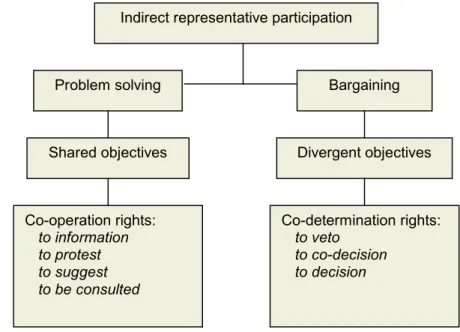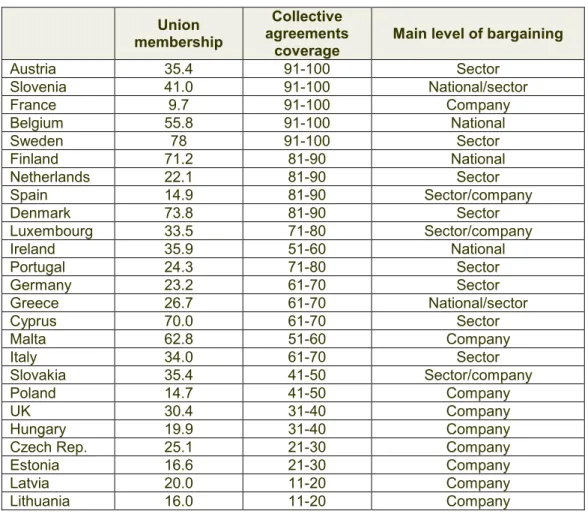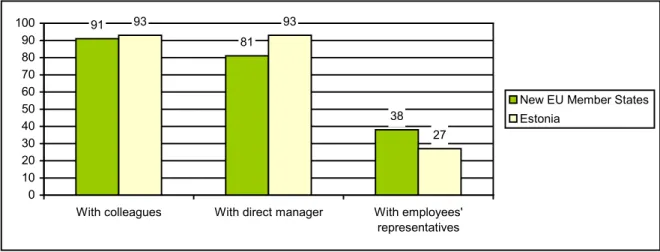The third chapter provides an overview of the legislation related to employee participation in Estonia and the relevant regulations in the European Union. Thus, employee participation depends on two dimensions: employee influence and decision importance.
THE CONCEPT OF EMPLOYEE INFORMATION AND CONSULTATION
D EFINITIONS AND E VIDENCE FROM P REVIOUS S TUDIES
- The Concept of Employee Participation: Information, Consultation and Co-determination 15
Furthermore, it is almost impossible to apply co-determination with direct participation, regardless of the size of the company. Legal provisions and collective agreements mainly refer to indirect participation, and the latter is also the focal point of the current study.

T HE I MPACT OF I NFORMATION AND C ONSULTATION P RACTICES ON E MPLOYEES ’ AND C OMPANIES ’ P ERFORMANCE
- Participation Effects on Employees – Direct versus Indirect Participation
- Employee Participation Effects on Companies
- Representation: Works Councils or Unions?
Works by Addison et al (1996) found that works councils lead to higher wages and lower employee turnover. In this context, works councils should be interpreted broadly as an alternative form of cooperation to the trade union.

EMPLOYEE REPRESENTATION FORMS AND INVOLVEMENT IN DECISION MAKING IN
- E MPLOYEE R EPRESENTATION IN THE EU C OUNTRIES
- S OME E XAMPLES FROM THE H ISTORY OF D IFFERENT R EGULATIONS
- W ORKS C OUNCILS IN THE E UROPEAN C OUNTRIES
- E MPLOYEE P ARTICIPATION IN M ANAGEMENT AND S UPERVISORY B OARDS IN THE E UROPEAN C OUNTRIES
In the following chapters, we will explain in more detail the institute of works councils and cooperation in company management. The largest number of works councils are established in Germany (113,000), and the fewest among the old EU members in Greece (126).
LEGISLATION AND REGULATIONS ON EMPLOYEES’ INFORMATION AND
E UROPEAN U NION R EGULATIONS
Objective: to set up a system of information and consultation in companies operating under the European Company Statute (Societas Europaea). Objective: to set up a system of information and consultation in cooperatives operating under the European Cooperative Society. This does not mean that there are no legal requirements for information and consultation in Britain.
These include e.g. the directive, which sets out basic rules for information and consultation in European companies and cooperatives. Employees' information and consultation in the event of collective redundancies is regulated in Directive 98/59/EC and in the case of business transfers in Directive 2001/23/EC. The directives on information and consultation in the event of collective redundancies and company transfers are transferred in principle with a few minor changes.
E STONIAN L EGISLATION
- Employees’ Representatives
- Rights for Information and Consultation
In the event of collective dismissal, the employer is obliged to consult with the employees. The employer must organize the election of the representative of the working environment in the general meeting of employees. The specific rights to information and consultation of employee representatives vary depending on the type of representation.
There are also some provisions for informing and consulting workers in the absence of representatives (see Box 3.2 for a brief description of the relevant legal acts). In case of violation of the obligations of information and consultation, the employer is forced to pay a fine of up to 6000 EEK in 2005. Thus, in the case of trade unions, the rights and obligations of information and consultation are more specific and there are specific fines in case of violation.
EMPLOYEE PARTICIPATION: EVIDENCE FROM ESTONIA
E MPLOYEE R EPRESENTATION AND P ARTICIPATION IN E STONIA ON THE B ASIS OF P REVIOUS S TUDIES
Partnership in business life 43 The workers assessed their opportunities to speak out or express dissatisfaction with their working conditions relatively positively. This proportion was slightly higher in the survey carried out by the European Institute for the Improvement of Living and Working Conditions: 77% of workers claimed to have the opportunity to discuss their working conditions. While 40% of workers in the new Member States claim to formally discuss working conditions, in Estonia the figure is only 12% (see Table 4.1).
Oxenbridge and Brown (2002) have found that informal partnership is more effective than formal partnership in relaying and considering employee opinions, but only in a situation where a representative (eg union) has a broad base. Note: In the case of Estonia, only active business units that had declared their turnover at least once during the last year were taken into account. However, the coverage and popularity of trade unions in the country does not express as a whole how well the employee representatives work in each company, and whether and what role representatives play in the companies where they are found.
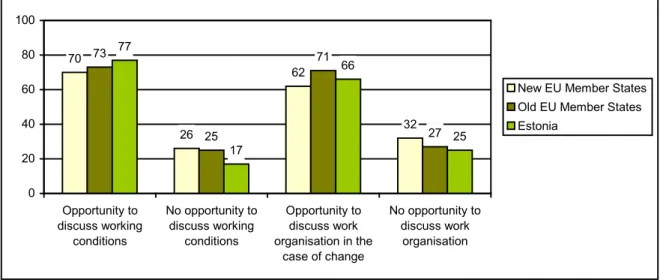
- Idea and Hypothesis
- Method of Study
The most important selection criterion was finding an interesting case to study from the point of view of the form of representation and the process of information and consultation. Thus, multiple sources of evidence were used to obtain a balanced picture of the current situation of information and consultation in companies. The interviews with company managers and employee representatives were semi-structured (see Appendix 3 for the interview structure), containing only general questions about information and consultation, while the order of questions was adjusted according to the topics raised by the interviewee.
The purpose of the interviews was to obtain a general picture of the employee participation process in the company, so that the employee questionnaires could be compared with the views of employee and employer representatives. The sample of workers was made on the basis of electronic personnel lists provided by the companies. The size of the sample in the companies, expressed as a percentage of the total number of employees, varied.
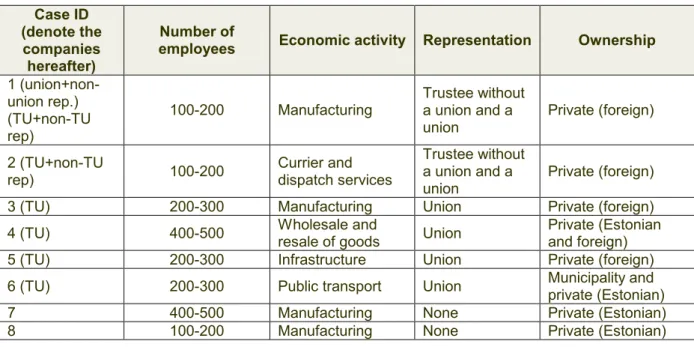
T HE I MPORTANCE OF E MPLOYEE P ARTICIPATION IN C OMPANIES
Learning about employees' opinions, invaluable information for future decisions, helps to see the shortcomings that management cannot;. Co-determination: Employees' opinions are often conflicting, and it is impossible to make a decision that takes all employees' opinions into account. It is not always possible to take the employees' opinion into account, as different employees have different opinions.
The employees' lack of interest in cooperation, the time factor and the possibility of information leakage stood out. Loss of employee interest in the company's future, which is replaced by self-interest. Employee alienation from the company Source: Interviews with managers and employee representatives compiled by the authors.
E MPLOYEE R EPRESENTATION
- Presence and Creation of Trade Unions
- Presence and Creation of Non-Unionised Representatives
- Other Forms of Employee Representation
There was a certain relationship between the share of trade union members and the level of satisfaction with the work of the union, i.e. the percentage of employees who turned to trade union representatives (TU) (Question Q15 in the questionnaire) and satisfaction with the work of the trade union representative (T14 in the questionnaire) between union members and non-union members. One company's non-union representative said the union's priorities were their confederation membership and legal aid.
However, it was likely that the existence of the institution of non-union representatives would impede future union expansion. In both companies, employees were slightly more satisfied with the work of the non-union representative than with the work of the union (see table 4.9). Based on the two analyzed cases, we can formulate a hypothesis that the institution of non-union representatives can be created in societies where the union is weak or has little coverage.

P ARTICIPATION P ROCESS : I NTENSITY , A REAS AND C HANNELS
- Participation Intensity
- Participation by Areas
- Participation Channels
- Documents Related to Participation and the Role of a Collective Agreement
Managers' assessment of the intensity of employee participation in their company (the figure shows case numbers with the extent of employee influence in each category of decisions) Source: Interviews, prepared by the authors. The employees' assessment of the possibility of having an influence on decisions about changing working hours (companies listed according to scope of consultation). Employees' assessment of the most important information channels about management decisions (3 to 4 most important channels presented) (% of respondents).
Employees' assessment of the main channels (3 most important channels presented) that they use to convey their opinions (% of respondents). In many companies, the collective agreement stipulated that it only covered the members of the union. In the companies analyzed in the present study, the number of employees varied from 150 to 450, but the existence of employee representatives was not related to the size of the company.
One of the conclusions from the case studies was that the existence of an employee representative does not guarantee higher participation intensity in the company. It is in the employer's interest to treat all employees equally and it is therefore common for the agreement to apply to all employees in the same way.

Works-councils
Automatic a) 15; b) 150 a) Elections based on the list of trade union candidates: b) Appointed by the members of the Netherlands Personnel Committee. Elected by the staff (at least 18 months of employment) from the list of candidates proposed by the trade unions. Legal information and consultation rights for trade unions, there is no works council body.
Board-level employee representation
In state-owned enterprises and companies where voluntary participation at the board level is foreseen, the employees choose the representative from the candidates nominated by the five nationally recognized trade unions. More than 2000 employees: ½ of the supervisory board (the chairman is the representative of the shareholders and has two votes in case of disagreement). The Director of Labor is appointed by the shareholders and cannot be done against the majority of the votes of the employees in the supervisory board. sector) Yes/Legislation The state runs "socialized societies" as public.
Employees of the company and trade union officials who participate in collective agreement negotiations may not be members of the board of directors. Employees' voice, in state-owned enterprises one board member is directly appointed by the trade union. 1/3-1/2 of the board (defined in the company's articles of association) and 1 member of the board if there are more than 500 employees.
Interview Structure with Heads of Companies and Employees' Representatives . 91
Does your company have other documents (in addition to the collective labor agreement and internal procedural rules) that provide information and consultation with employees? How familiar do you think the employees in your company are on average with the documents mentioned? In this part of the questionnaire we would like to know how employees communicate with management in your company.
How well do you know the contents of the document mentioned in the previous question. With this question we would like to know how information and consultation take place within your company (regardless of whether this is directly with you or through an employee representative). If management seeks employees' views on their decisions, please give you/the employee representative sufficient time to formulate and present such views.
